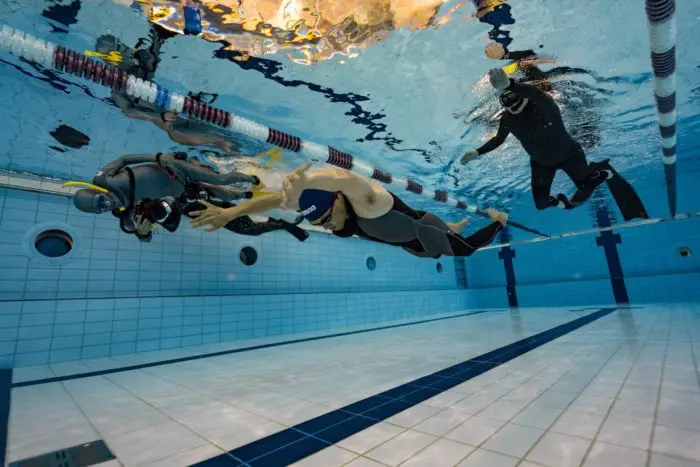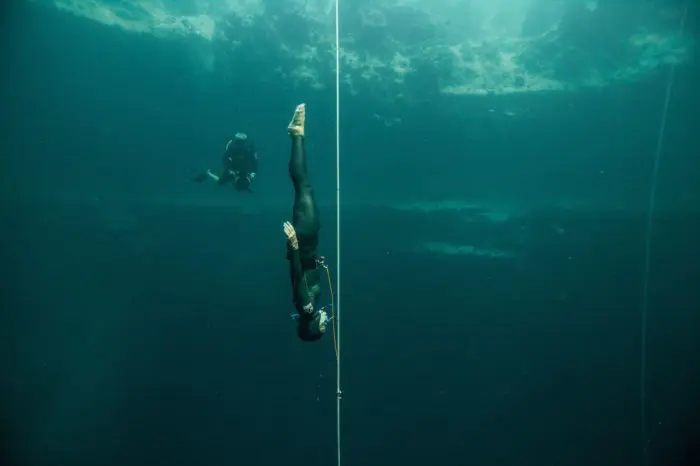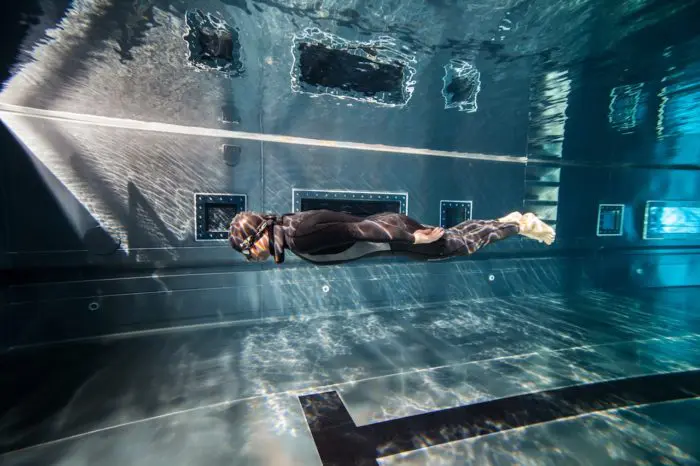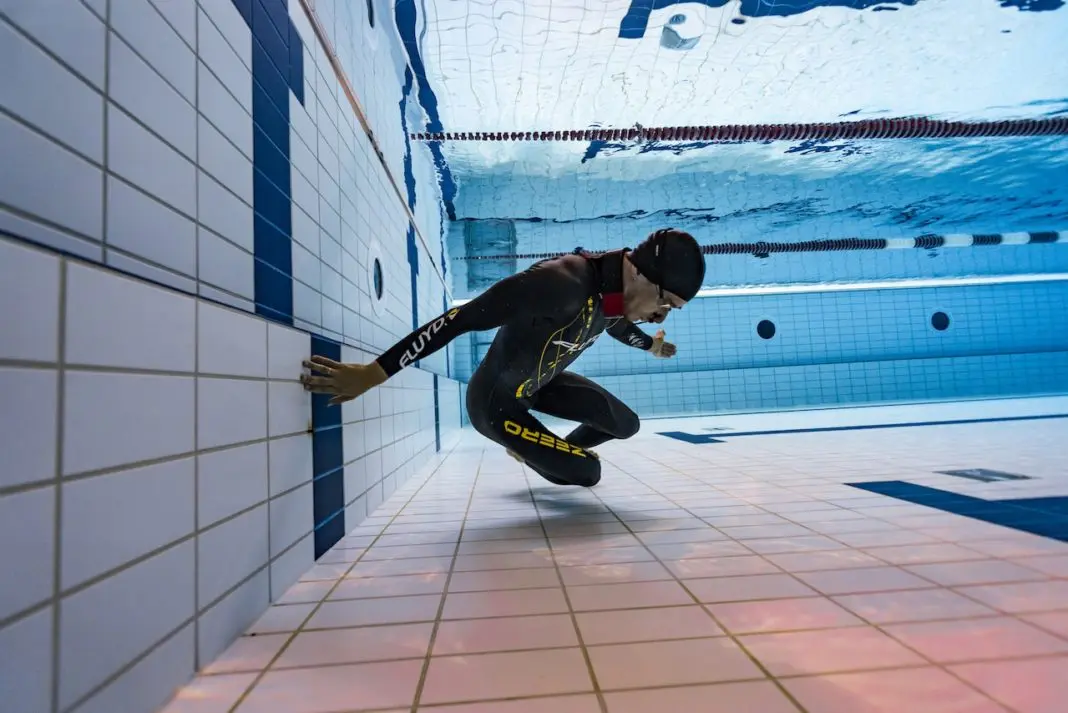Many consider no-fins diving the most natural, purest form of freediving. Equipment cannot help you – you must rely only on your strength and technique. This fact also makes no-fins one of the most challenging disciplines in freediving.
Dynamic No Fins (DNF), or swimming horizontally for a distance on one breath without fins, and Constant Weight No Fins (CNF), or swimming vertically for depth on one breath without fins, can be a daunting discipline. Suppose you choose to pursue either one of these disciplines seriously. In that case, it’s recommended to learn freediving with an agency that includes no-fins in their courses (like Molchanovs Lap/Wave courses) or to hire a freediving coach or instructor specifically for no-fins technique.
If neither of these options is within reach and you are a certified freediver, you can always grab another certified freediving buddy and slowly train the technique yourselves. There are already plenty of videos and articles on how to perform the no-fins technique, but this article will focus on tips for training no-fins with your buddy.
We at DeeperBlue.com never recommend you to freedive alone. We strongly urge non-certified freedivers to take a certified freediving course and only dive with certified buddies familiar with buddying and rescue procedures.
Practice in the pool

The pool is essential for both DNF and CNF. This is where you learn the basics of your technique and where you will continue training it to be more streamlined. In the pool, you can grab a mask, snorkel, and train only your arm strokes at the surface. Count how many arm strokes it takes to reach the other end of the pool, and remember that number. Then, continue to work on decreasing that number by increasing the efficiency of your movements. You can do the same with leg strokes by holding a kickboard with outstretched arms and a leg board (or even a plastic bottle) between your knees.
Later, you can individually practice arm strokes and leg strokes on a breath hold under the surface (after checking, you have perfect neutral buoyancy).
Neutral buoyancy
Neutral buoyancy is non-negotiable in both pool and open water. In the pool, if you are constantly positively buoyant, you will swim diagonally to stay near the pool bottom, which creates drag. It also may change your strokes as you attempt to correct your positioning, creating a compromised technique that can, in turn, become muscle memory. Ideal neutral buoyancy and trim (spoken about in the ‘Neck weight’ section below) can be difficult in the pool, as many factors are involved (wetsuit thickness, gender, weight loss/gain, etc.), so be patient and adjust session-by-session if needed.
In open water, neutral buoyancy should be measured without fins and set at about 1/3 of your target depth or an absolute minimum of 10m (32ft). Do not be tempted to be overweight or underweight yourself to have an easier ascent or descent. For example, if you underweight yourself to have an easier ascent that starts earlier, you will still expend more energy fighting against positive buoyancy on the descent. The same goes for overweighting yourself (and you should NEVER be neutrally buoyant at a depth shallower than 10m).
Train the push-off/duck dive
A good start in DNF and CNF is necessary for efficient performance. In the pool, you can train the push-off from one end of the pool and glide for as long as possible until you come to a complete stop. Then, surface and take note of where you ended up, and try again and again to make the glide phase longer.
You will need a good duck dive in open water to descend effectively beneath that positive buoyancy at the surface. Duck dives without fins will feel strange at first, so practice it until it feels comfortable and looks as good as it feels. Make sure you’ve measured your neutral buoyancy (without fins) using FIM before working on the no-fins duck dive.
Take videos

The most helpful thing you can do during your no-fins training is to have your buddy take videos. In the pool, you can take videos from the surface while walking along the pool edge and horizontally at depth. Here, you can check for common mistakes, such as your butt sticking out or your legs bending too far forward at the hips during a leg stroke. In open water, have a buddy follow you to depth (remember that this buddy cannot act as your safety, you will need a buddy who dives after you for safety). Analyze these videos afterward – it is much easier to understand your mistakes when you can see yourself making them.
Nose clip
A nose clip is a must for CNF because it removes the need to equalize and break streamlining before performing arm strokes. In DNF, most freedivers use a nose clip and swimming goggles for performances. However, swimming goggles cannot be used at depth since you cannot equalize the air spaces inside them. Nose clips can take some time to get used to, and when you train, you should only focus on one new element at a time. Therefore, you must repeatedly practice Free Immersion (FIM) with a nose clip and feel comfortable with it before using it in your no-fins dives. Make sure to slightly open your eyes every once in a while during your FIM dives to get used to looking at the line.
Neck weight

Neck weights are helpful for both pool and open water, and having excellent trim (body position underwater) in the pool is an absolute must for DNF. Remember that in a horizontal position, your most buoyant point is your upper body, where your lungs are. If you only wear a weight belt, your body position might still be diagonal because your upper body is more buoyant. This can be corrected with a neck weight – many freedivers like Lobster neck weights for the fact that they can add or subtract weights easily.
In open water, neck weights help you move the center of gravity toward your head, giving you a more streamlined position during freefall. Controlling freefall with no fins is much more complex than with fins, so use a neck weight and practice an efficient freefall for CNF (which you can do by diving FIM with no fins).
Combine FIM with arm strokes or leg strokes
Doing multiple CNF dives in one training session can be extremely tiring because lactic acid (that ‘burning’ in your arms and legs after a CNF performance) builds up quickly on a breath hold. Instead of multiple CNF dives, you can also consider performing FIM down to a manageable depth, then performing only arm strokes on the way up. The same can be done with leg strokes.
This way, you can focus on a single element of your CNF performance multiple times without tiring yourself out quickly. It is also safer, as you are saving energy on the descent and expending energy on the ascent while mostly in the zone of positive buoyancy. You can increase depth slowly to allow you to perform arm or leg strokes in a single dive. You can also count them and test the efficiency of each movement (similar to how you would do in the pool).
Final thoughts
No-fins training is difficult to perfect, but it can also be fun! Remember that nothing replaces learning from a qualified instructor during a course or working with a freediving coach. But for those in-between times or training more for fun than for performance, use the tips above to dip your toes into the world of no fins.

